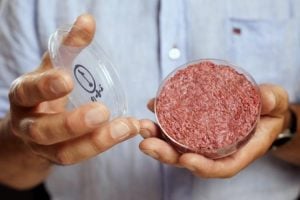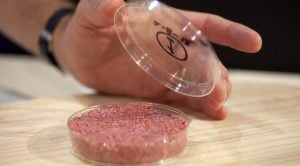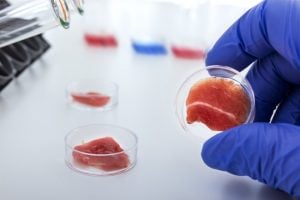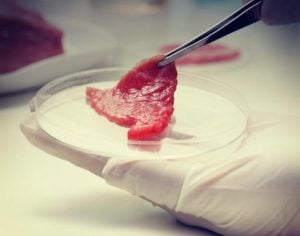 It has been long known that meat production consumes a lot of energy, requires huge amounts of meadow and field surface. In general, it harms our environment. If there is a problem, it is obvious that we will start looking for solutions. But are the solutions that scientists currently work on are good ones? Hm… it looks like opinions are divided…
It has been long known that meat production consumes a lot of energy, requires huge amounts of meadow and field surface. In general, it harms our environment. If there is a problem, it is obvious that we will start looking for solutions. But are the solutions that scientists currently work on are good ones? Hm… it looks like opinions are divided…
First a brief summary of the problem of meat production.
Already in 1990, researchers at the World Hunger Program calculated that the surface that was then used for food production, could provide food for 6 billion people on a vegetarian diet, whereas for people on a traditional diet containing meat, the same surface would only provide food for 2.6 billion people. Our population is growing all the time … Not only have we exceeded 6 billion … Today, the world population has reached 7.4 billion. As a result fo this, 40% of the forests in Central America have been cut or burned in the past 40 years. These areas were mainly intended for the production of cattle feed. In the United States, 56 million acres produce plants for animal feed, while only 4 million acres are fields where vegetables are grown for us.
Although we have already exceeded 7.4 billion, we only use half of the world’s drinking water consumption. The second half of the drinking water is intended for breeding animals. It should be noted that a diet containing meat requires 14 times more potable water compared to a vegan diet.
Of course, it is not only water that we need for meat production, energy is also consumed in huge quantities by livestock farms, slaughterhouses and meat producers. In order to produce one calorie derived from animal protein, 28 calories are used on average. While it takes only 3.3 calories of fuel to produce one calorie derived from cereals. It is also worth noting that 70% of cultivated cereals are intended for livestock feed.
Just as our planet has limited space, water or mine resources, it also has the limited capacity to dispose of and neutralise the waste that our civilisation produces. Undoubtedly, the largest producer of waste are the huge animal farms. In the United States alone, an animal farm produces 130 times more waste than a city of the same area.
The above facts are just the beginning of the problem of meat production. I could talk a lot also about reduction of animal biodiversity, global warming and the spread of diseases. But that we all have known for a long time, and I did not want to focus on the problem itself, but on its solution.
 Scientists, as always, transfer all the world’s quarries to the lab. The technology of mouse, rat or human cell growth is well known. Going further, one could grow pork, beef or poultry in the laboratory. And it happened! In 2013, the first meat burger was created in the laboratory. As you may have guessed, ground meat is much easier to reconstitute compared to the texture of chicken breast or beef steak. That is why the work goes on, because you have to make progress after all.
Scientists, as always, transfer all the world’s quarries to the lab. The technology of mouse, rat or human cell growth is well known. Going further, one could grow pork, beef or poultry in the laboratory. And it happened! In 2013, the first meat burger was created in the laboratory. As you may have guessed, ground meat is much easier to reconstitute compared to the texture of chicken breast or beef steak. That is why the work goes on, because you have to make progress after all.
Modern Meadow in New York is trying to create meat with 3D printing technology. “Meat prints” look beautiful and have an appropriate structure. Creating chicken legs with bone and cartilage is easy enough. However, scientists have trouble reproducing the taste …. From the statistics we know that consumers distinguish meat according to how the animal was fed. 88% of the buyers prefer the beef flavour of cows fed with feed, while only 12% prefer the beef of cows eating grass. Such detailed diversification of chemical composition of meat created by 3D technology is becoming a challenge for scientists.
 We have meat texture, but we do not have the taste … So back to the meat of the tube technology. Here the leader turns out to be the Memphis Meats. In February 2016 they created their furst product – meatballs. In August this year, Memphis Meats received € 17 million for the development of synthetic meat growth technology. Investors of this venture are Microsoft Bill Gates, Virgin Richard Branson as well as Cargill, one of the world’s biggest agricultural companies. Memphis Meats plans to allocate these resources to improve the meat texture so that the steak looks like a steak, and the chicken breast looks like chicken breast. Work will also continue to reduce the cost of production technology. The team of chefs, academics and marketers is expected to increase fourfold. Additionally, a big team of people will work to speed up the development of meat-processing technology in the laboratory. Memphis Meats wants to market its meat products from the tube in two to three years. The first products to appear in the stores are turkey meat, hot dogs, sausages, burgers and desserts. We are waiting!
We have meat texture, but we do not have the taste … So back to the meat of the tube technology. Here the leader turns out to be the Memphis Meats. In February 2016 they created their furst product – meatballs. In August this year, Memphis Meats received € 17 million for the development of synthetic meat growth technology. Investors of this venture are Microsoft Bill Gates, Virgin Richard Branson as well as Cargill, one of the world’s biggest agricultural companies. Memphis Meats plans to allocate these resources to improve the meat texture so that the steak looks like a steak, and the chicken breast looks like chicken breast. Work will also continue to reduce the cost of production technology. The team of chefs, academics and marketers is expected to increase fourfold. Additionally, a big team of people will work to speed up the development of meat-processing technology in the laboratory. Memphis Meats wants to market its meat products from the tube in two to three years. The first products to appear in the stores are turkey meat, hot dogs, sausages, burgers and desserts. We are waiting!
Well … and what are the conclusions here? How to sum up all of this?
Maybe I should say: “Meat from the tube? Really?! Another scientific idea that in 30 years will turn out to be carcinogenic and harmful to our health … “? In line with the proverb “you are what you eat” we will become a laboratory! Of course, like in every lab, not every experiment is successful … What if we find that in the laboratory, that is our body, we will create an explosive mixture? What if eating meat from the test tube for years will cause the destruction of internal organs? We wanted to limit animal fats, we wanted to eliminate butter. We have developed a technology for hardening vegetable fats, resulting in margarine. After years, it turned out that trans fats were also created, which our body does not cope with. Instead of improving the statistics of civilisation diseases, we have worsened them … In scientific laboratories a product of unknown long-term effects is being produced, and it is expected to be marketed in two years?
Maybe I should say, “I’m looking forward to stopping the destruction of our planet by breeding animals”? Sure, I agree and that’s what I think. Eating meat contributes greatly to the increase in obesity. Meat is fried, coated, fried in deep fat … Very frequently meat plays a major role on our plate, and high-quality vegetables are forgotten … Limiting meat intake would surely leave the society healthier and reduce the problem of obesity. Since I am not convinced about synthetic meat, maybe in two years time I should be advising not only to restrict but completely eliminate meat from our diet and shift to vegetarianism or veganism.
 The problem, however, is that obesity already exists amongst us to a great extent. During the reduction it is very important to provide the right amount of protein in the diet. Meat is a valuable and well-assimilable source of protein. The demand for this macroelement is easily fulfilled by eating meat. Apart from, reduction diet, meat in the ketogenic diet also plays an important role. A ketogenic diet is in turn very much needed in the fight against epilepsy or the prevention of Alzheimer’s disease.
The problem, however, is that obesity already exists amongst us to a great extent. During the reduction it is very important to provide the right amount of protein in the diet. Meat is a valuable and well-assimilable source of protein. The demand for this macroelement is easily fulfilled by eating meat. Apart from, reduction diet, meat in the ketogenic diet also plays an important role. A ketogenic diet is in turn very much needed in the fight against epilepsy or the prevention of Alzheimer’s disease.
Maybe there is some safe middle? Albert Einstein believed that “nothing will bring greater health benefits to human health and will not increase the chance of survival on Earth as much as the evolution of vegetarian diet.” Evolution – I think this is a good word. Let’s move on to vegetarianism. Maybe it will slowly decrease the phenomenon of obesity, and certainly reduce the need to produce meat from the test tube … However, even if we manage to fight obesity, can we also eliminate the occurrence of epilepsy, Alzheimer’s or other diseases, when the protein diet benefits health? I do not think so … That’s why we should have a choice! We should be able to voluntarily switch to vegetarianism. We should be able to buy lean meat and make a healthy meal. If the market gets flooded by inexpensive synthetic meat products, the price of traditional meat will increase several times. Perhaps the meat traditionally produced will cease to exist completely… For ecology and the environment it would be great! However, there are still people out there who, from a medical point of view, need to eat a lot of protein … And what about them? The cursed circle of questions closes … the problem is not solved ….

